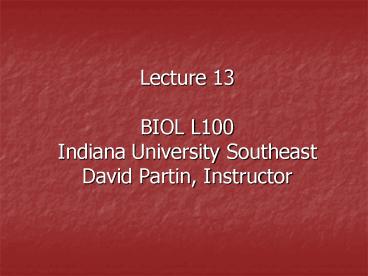Lecture 13 BIOL L100 Indiana University Southeast David Partin, Instructor - PowerPoint PPT Presentation
1 / 32
Title:
Lecture 13 BIOL L100 Indiana University Southeast David Partin, Instructor
Description:
Animals are classified based on ... Type of body plan (sac or tube-in-a-tube) Type of coelom (no/maybe/yes) Segmentation (yes/no) ... Read/Skim Ch 33, 34 & 37 ... – PowerPoint PPT presentation
Number of Views:64
Avg rating:3.0/5.0
Title: Lecture 13 BIOL L100 Indiana University Southeast David Partin, Instructor
1
Lecture 13BIOL L100 Indiana University
SoutheastDavid Partin, Instructor
2
Todays Plan
- Announcements/Questions
- Lecture Kingdom Animalia
- One Minute paper
- Lab
3
Kingdom Animalia commonalities
- All organisms in this kingdom have 3 common
characteristics - Multicellular
- Eukaryotic
- Heterotrophic
4
Kingdom Animalia classification
- Animals are classified based on their
differences - Level of organization (cells, tissues, organs)
- Type of symmetry (radial, bilateral)
- Type of body plan (sac or tube-in-a-tube)
- Type of coelom (no/maybe/yes)
- Segmentation (yes/no)
5
Kingdom Animalia classification
enlarged slide attached for further study
6
Kingdom Animalia classification
enlarged slide attached for further study
7
Kingdom AnimaliaPhylum Porifera
- Sponges!
- Cellular level of organization, but no true
tissues - The only animals whose complete digestion occurs
in cells. - Sessile
- Filter feeders
8
Kingdom AnimaliaPhylum Porifera
9
Background different types of body symmetry
Usually more complicated organisms
Usually simpler organisms
10
Kingdom AnimaliaPhyla Ctenophora Cnidaria
- Phylum Ctenophora comb jellies
- Ciliates
- Covered in sticky mucus
- Phylum Cnidaria Jelly fish
- Organized tissues
- Radial symmetry
- Sac body plan
- Specialized stinging cells
11
Kingdom AnimaliaPhyla Ctenophora Cnidaria
12
Background types of coelomes (body cavities)
13
(No Transcript)
14
Kingdom AnimaliaPhyla Platyhelminthes
- Phylum Platyhelminthes
- Flat worms (planarians, flukes, tapeworms)
- Free living or parasitic
- Organized tissues, bilateral symmetry, acoelomate
15
Hookworms, pinworms, tapeworms removed from a
Brazilian boy treated on a Rockefeller foundation
mission, early-mid 1900s.
These parasites still affect people all over the
globe. Infection is a sign of poor sanitation
and often a sign of poverty.
16
(No Transcript)
17
Kingdom AnimaliaPhylum Nematoda
- Roundworms
- Smooth, non-segmented
- Organized tissues, bilateral symmetry,
pseudocoelomate - Several are
- parasitic
- Colorless
- Found almost
- anywhere
18
Kingdom AnimaliaPhylum Nematoda
Dirofilaria is a roundworm that causes heartworm
disease in dogs.
19
Kingdom AnimaliaPhylum Nematoda
The roundworm is carried by mosquitoes in
tropical Africa.
Elephantiasis results when a roundworm blocks the
lymphatic system, causing severe swelling.
20
Ascaris a parasitic roundworm
21
Kingdom AnimaliaPhylum Rotifera
- Organized tissues, bilateral symmetry,
pseudocoelomate - Found in fresh water (ponds, lakes, gutters,
sewers, moist soil, moss, lichens - Mouth surrounded by waving cilia
22
Need a break?
- Thanks for your attention!
- Take 10 minutes.
23
Protostome vs. Deuterostome Coelomates have 2
openings in the digestive tract a mouth and an
anus. In a protostome embryo, the first opening
that develops is the mouth and the second opening
is the anus. In deuterostomes, the first opening
that develops in the embryo is the anus and the
second opening is the mouth.
24
Kingdom AnimaliaPhylum Mollusca
- Snails, slugs, clams, mussels, squids, octopi
- Organized tissues,
- bilateral symmetry,
- coelomates,
- protostomes,
- non-segmented
25
Kingdom AnimaliaPhylum Annelida
- Segmented worms (including earthworms leeches)
- Organized tissues, bilateral symmetry,
coelomates, protostomes, segmented body
26
Kingdom AnimaliaPhylum Arthropoda
- Includes spiders, scorpions, crabs, lobsters,
crayfish, shrimp, centipedes, millipedes, insects - Most successful of all animal phyla
- Organized tissues, bilateral symmetry,
coelomates, protostomes, segmented body - Arthropod literally means jointed foot
- Freely moving jointed appendages, exoskeleton,
well-developed nervous system, variety of
respiratory organs, metamorphosis
27
Kingdom AnimaliaPhylum Echinodermata
- Literally means spiny skin
- Includes starfish, sand dollars, etc.
- Organized tissues, bilateral symmetry in larvae
(metamorphosis results in radial symmetry in
adults), coelomates, deuterostomes - Endoskeleton, water vascular system
28
Kingdom AnimaliaPhylum Chordata
- Must have organized tissues, bilateral symmetry,
coelome, deuterostome, PLUS 4 OTHER
CHARACTERISTICS - 1. notochord dorsal
- supporting rod
- 2. nerve cord dorsal
- tubular rod
- 3. pharyngeal pouches
- 4. post-anal tail
29
Each of these is a Class in the Phylum Chordata
enlarged slide attached for further study
30
Kingdom AnimaliaPhylum ChordataClass Mammalia
- Mammals share the following features, with very
few exceptions - Body hair, differentiated teeth, well-developed
brain, infant dependency, mammary glands,
endothermic, internal development
31
Need a break?
- Thanks for your attention!
- Take 10 minutes if you need it.
- Whats next?
- 1-minute paper
- Lab
32
Preparation for Lecture 14
- Read/Skim Ch 33, 34 37
- Pay special attention to the diagrams on pages
616, 617 and 676. These diagrams will be very
helpful for lab.































